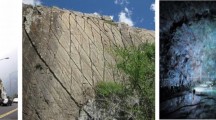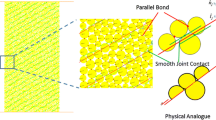Abstract
Understanding the anisotropic behavior of jointed rock mass subjected to various confining pressures is crucial for designing, evaluating the performance and assessing the stability of rock engineering structures. We report here our numerical investigation of the response of stress-dependent anisotropy of a jointed rock mass sourced from the weakly weathered zone of the water inlet slope of the Xiaowan Hydropower Station, China. The finite element method (FEM) that incorporates material heterogeneity and joint network was utilized. Two-dimensional models were established based on the Monte-Carlo method and loaded in different rotational angles with changing confining pressures at the representative elementary volume (REV) size (14 × 14 m). The stress–strain behaviors, failure patterns, deformation modulus and peak strength of the REV models exhibited noticeable stress dependency and directionality. The cohesive strength was anisotropic, whereas there was only an insignificant change in the friction angle with changes in the rotational angle. The effect of confining pressure on the anisotropy index of the deformation modulus was negligible, while the anisotropy index of peak strength decreased gradually with confining pressure. Based on these results, we conclude that stress conditions need to be considered for accurate prediction of the mechanical behavior of a jointed rock mass.
















Similar content being viewed by others
References
Al-Harthi AA (1998) Effect of planar structures on the anisotropy of ranyah sandstone, Saudi Arabia. Eng Geol 50(97):49–57
Alshkane YM, Marshall AM, Stace LR (2017) Prediction of strength and deformability of an interlocked blocky rock mass using UDEC. J Rock Mech Geotech Eng 9(3):149–160
Attewell PB, Sandford MR (1974) Intrinsic shear strength of a brittle, anisotropic rock—III: textural interpretation of failure. Int J Rock Mech Min Sci Geomech Abstr 11(11):431–438
Baghbanan A (2008) Stress and scale-dependency of hydromechanical properties of fractured rocks. Isfahan University of Technology, Isfahan
Bahaaddini M, Hagan PC, Mitra R, Hebblewhite BK (2014) Scale effect on the shear behaviour of rock joints based on a numerical study. Eng Geol 181:212–223
Behrestaghi MHN, Rao KS, Ramamurthy T (1996) Engineering geological and geotechnical responses of schistose rocks from dam project areas in India. Eng Geol 44(1–4):183–201
Bidgoli MN, Jing L (2014) Anisotropy of strength and deformability of fractured rocks. J Rock Mech Geotech Eng 6(2):156–164
Bidgoli MN, Zhao Z, Jing L (2013) Numerical evaluation of strength and deformability of fractured rocks. J Rock Mech Geotech Eng 5(6):419–430
Bidgoli MN, Jing L (2015) Stochastic analysis of strength and deformability of fractured rocks using multi-fracture system realizations. Int J Rock Mech Min Sci 78(4):108–117
Bieniawski ZT (1968) The effect of specimen size on compressive strength of coal. Int J Rock Mech Min Sci Geomech Abstr 5(4):325–335
Chappell BA (1990) Moduli stress dependency in anisotropic rock masses. Min Sci Technol 10(2):127–143
Esmaieli K, Hadjigeorgiou J, Grenon M (2010) Estimating geometrical and mechanical REV based on synthetic rock mass models at Brunswick mine. Int J Rock Mech Min Sci 47(6):915–926
Fan LF, Wu ZJ, Wan Z, Gao JW (2017) Experimental investigation of thermal effects on dynamic behavior of granite. Appl Therm Eng 125:94–103
Fan LF, Gao JW, Wu ZJ, Yang SQ, Ma GW (2018) An investigation of thermal effects on micro-properties of granite by X-ray CT technique. Appl Therm Eng 140:505–519
Fereidooni D, Khanlari GR, Heidari M, Sepahigero AA, Kolahi-Azar AP (2016) Assessment of inherent anisotropy and confining pressure influences on mechanical behavior of anisotropic foliated rocks under triaxial compression. Rock Mech Rock Eng 49(6):2155–2163
Gonzaga GG, Leite MH, Corthésy R (2008) Determination of anisotropic deformability parameters from a single standard rock specimen. Int J Rock Mech Min Sci 45(8):1420–1438
Hoek E, Brown ET (1980) Empirical strength criterion for rock masses. J Geotech Eng Div ASCE 106(GT9):1013–1103
Jing L, Hudson JA (2002) Numerical methods in rock mechanics. Int J Rock Mech Min Sci 39(4):409–427
Kemeny JM (1991) A model for non-linear rock deformation under compression due to sub-critical crack growth. Int J Rock Mech Min Sci Geomech Abstr 28(6):459–467
Khani A, Baghbanan A, Norouzi S, Hashemolhosseini H (2013) Effects of fracture geometry and stress on the strength of a fractured rock mass. Int J Rock Mech Min Sci 60(8):345–352
Kim H, Cho JW, Song I, Min KB (2012) Anisotropy of elastic moduli, p-wave velocities, and thermal conductivities of Asan gneiss, boryeong shale, and yeoncheon schist in Korea. Eng Geol 147-148(5):68–77
Kohl T, Evansi KF, Hopkirk RJ, Rybach L (1995) Coupled hydraulic, thermal and mechanical considerations for the simulation of hot dry rock reservoirs. Geothermics 24(24):345–359
Kulatilake PHSW, Ucpirti H, Stephansson O (1994) Effects of finite-size joints on the deformability of jointed rock at. Can Geotech J 31(3):364–374
Kulatilake PHSW, Park J, Um JG (2004) Estimation of rock mass strength and deformability in 3-d for a 30 m cube at a depth of 485 m at Äspö hard rock laboratory. Geotech Geol Eng 22(3):313–330
Kumar A (2006) Engineering behaviour of anisotropic rocks. PhD thesis. Department of Civil Engineering, Indian Institute of Technology, Roorkee
Kumar R, Verma AK (2016) Anisotropic shear behavior of rock joint replicas. Int J Rock Mech Min Sci 90:62–73
Li JH, Zhang LM, Wang Y, Fredlund DG (2009) Permeability tensor and representative elementary volume of saturated cracked soil. Can Geotech J 46(8):928–942
Li LC, Tang CA, Zhu WC, Liang ZZ (2009) Numerical analysis of slope stability based on the gravity increase method. Comput Geotech 36(7):1246–1258
Li LC, Yang TH, Liang ZZ, Zhu WC, Tang CA (2011) Numerical investigation of groundwater outbursts near faults in underground coal mines. Int J Coal Geol 85(3–4):276–288
Liang ZZ, Tang CA, Li HX, Zhang YB (2004) Numerical simulation of the 3-D failure process in heterogeneous rocks. Int J Rock Mech Min Sci 41(3):419–419
Liu XZ, Tang CA, Li LC, Lv PF, Liu HY (2017) Microseismic monitoring and 3D finite element analysis of the right bank slope, Dagangshan Hydropower Station, during reservoir impounding. Rock Mech Rock Eng 50(7):1901–1917
Maji VB, Sitharam TG (2012) Testing and evaluation of strength and deformation behaviour of jointed rocks. Geomech Geoeng 7(2):149–158
Mazars J, Pijaudier-Cabot G (1989) Continuum damage theory—application to concrete. J Eng Mech 115(2):345–365
Min KB, Jing L (2004) Stress dependent mechanical properties and bounds of poisson's ratio for fractured rock masses investigated by a DFN-DEM technique. Int J Rock Mech Min Sci 41(3):431–432
Pariseau WG, Puri S, Schmelter SC (2008) A new model for effects of impersistent joint sets on rock slope stability. Int J Rock Mech Min Sci 45(2):122–131
Ramamurthy T, Rao GV, Singh J (1993) Engineering behaviour of phyllites. Eng Geol 33(3):209–225
Rao KS (1984) Strength and deformation behaviour of sandstones. PhD Thesis. Indian Institute of Technology, Delhi
Sahoo S (2011) A Study on strength and deformation behaviour of jointed rock mass. PhD thesis. Department of Civil Engineering, Indian Institute of Technology, Delhi
Singh M, Rao KS (2005) Empirical methods to estimate the strength of jointed rock masses. Eng Geol 77(1–2):127–137
Singh M, Samadhiya NK, Kumar A, Kumar V, Singh B (2015) A nonlinear criterion for triaxial strength of inherently anisotropic rocks. Rock Mech Rock Eng 48(4):1387–1405
Tang CA (1997) Numerical simulation on progressive failure leading to collapse and associated seismicity. Int J Rock Mech Min Sci 34(2):249–261
Tang CA, Lin P, Wong RHC, Chau KT (2001) Analysis of crack coalescence in rock-like materials containing three flaws-part II: numerical approach. Int J Rock Mech Min Sci 38(7):925–939
Tang CA, Wong RHC, Chau KT, Lin P (2005) Modeling of compression-induced splitting failure in heterogeneous brittle porous solids. Eng Fract Mech 72(4):597–615
Tiwari RP, Rao KS (2007) Response of an anisotropic rock mass under polyaxial stress state. J Mater Civ Eng 19(5):393–403
Wang PT, Yang TH, Xu T, Cai MF, Li CH (2016) Numerical analysis on scale effect of elasticity, strength and failure patterns of jointed rock masses. Geosci J 20(4):1–11
Wang X, Jia Z, Zhang F, Li X (2010) The simulation of joint network and its application. China Water Power Press, Beijing
Weibull W (1951) A statistical distribution function of wide applicability. J Appl Mech 18:293–297
Wu Q, Kulatilake PHSW (2012) REV and its properties on fracture system and mechanical properties, and an orthotropic constitutive model for a jointed rock mass in a dam site in China. Comput Geotech 43(3):124–142
Wu ZJ, Fan LF, Liu QS, Ma GW (2017) Micro-mechanical modeling of the macro-mechanical response and fracture behavior of rock using the numerical manifold method. Eng Geol 225:49–60
Xu GW, He C, Su A, Chen ZQ (2018) Experimental investigation of the anisotropic mechanical behavior of phyllite under triaxial compression. Int J Rock Mech Min Sci 104:100–112
Xu T, Ranjith PG, Wasantha PLP, Zhao J, Tang CA, Zhu WC (2013) Influence of the geometry of partially-spanning joints on mechanical properties of rock in uniaxial compression. Eng Geol 167:134–147
Yan YL, Xu T, Zhang YJ, Wasantha PLP (2013) Numerical simulation of the effect of joint orientation on the failure strength of rock. Appl Mech Mater 477-478:5
Yang JP, Chen WZ, Yang DS, Yuan JQ (2015a) Numerical determination of strength and deformability of fractured rock mass by FEM modeling. Comput Geotech 64:20–31
Yang SQ, Jing HW (2011) Strength failure and crack coalescence behavior of brittle sandstone samples containing a single fissure under uniaxial compression. Int J Fract 168:227–250
Yang TH, Wang PT, Xu T, Yu QL, Zhang PH, Shi WH, Hu GJ (2015b) Anisotropic characteristics of jointed rock mass: a case study at shirengou iron ore mine in China. Tunn Undergr Space Technol 48:129–139
Zhang HH, Liu SM, Han SY, Fan LF (2018) Modeling of 2D cracked FGMs under thermo-mechanical loadings with the numerical manifold method. Int J Mech Sci 148:103–117
Zhang JC, Zhou SH, Xu XH, Fang LG (2013) Evolution of the elastic properties of a bedded argillite damaged in cyclic triaxial tests. Int J Rock Mech Min Sci 58(1):103–110
Zhang XP, Wong LNY, Wang SJ, Han GY (2011) Engineering properties of quartz mica schist. Eng Geol 121(3):135–149
Zhou JR, Wei J, Yang TH, Zhu WC, Li LC, Zhang PH (2018) Damage analysis of rock mass coupling joints, water and microseismicity. Tunn Undergr Space Technol 71:366–381
Zhu WC, Tang CA (2004) Micromechanical model for simulating the fracture process of rock. Rock Mech Rock Eng 37(1):25–56
Acknowledgements
This study is supported by the National key research and development program(2016YFBO201000) and the National Natural Science Foundation of China (Grant No. 51779031).
Author information
Authors and Affiliations
Corresponding author
Rights and permissions
About this article
Cite this article
Wu, N., Liang, Zz., Li, Yc. et al. Stress-dependent anisotropy index of strength and deformability of jointed rock mass: insights from a numerical study. Bull Eng Geol Environ 78, 5905–5917 (2019). https://doi.org/10.1007/s10064-019-01483-5
Received:
Accepted:
Published:
Issue Date:
DOI: https://doi.org/10.1007/s10064-019-01483-5




